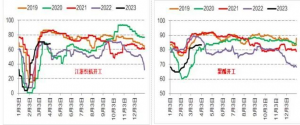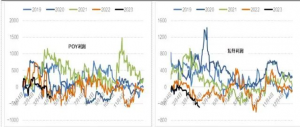Red flag, textile exports down 22.4%!
According to the General Administration of Customs, the export of textile and clothing in January and February was 40.84 billion US dollars, down 18.6% year on year, among which the export of textile was 19.16 billion US dollars, down 22.4% year on year, and the export of clothing and clothing was 21.68 billion US dollars, down 14.7% year on year. In terms of domestic consumption, the retail sales of textile and apparel in January-February totaled 254.90 billion yuan, up 5.4% year on year. From the data point of view, with the relaxation of epidemic control at the end of last year, the passenger volume in key cities picked up rapidly, the offline consumption scene was fully recovered, and the pre-accumulated part of consumption was released “retaliatory” in January and February. The terminal data showed considerable growth year-on-year. However, in terms of foreign trade, due to the adverse impact of overdraft demand and interest rate hike, the export of textile and clothing fell sharply year-on-year. As a result, the overall recovery in demand has fallen short of the optimistic pre-Spring Festival expectations.
At present, as the stock orders were delivered one after another, while the new orders were not followed up enough, the loom load of Jiangsu and Zhejiang fell in late March. From last weekend, the downward load of various downstream regions accelerated, and it is expected to drop to a stage low around Qingming. It is preliminarily predicted that the probability of bomb and weaving in Jiangsu and Zhejiang will decrease to around 70% and around 60% respectively.
Among them, the rate of decline in various places is affected by the pre-stock of raw materials. The factories with less stock have been parking and reducing the load in the first two days. And the early stock of raw materials a little more factories have planned 8-10 days around parking or negative.
For each region, Taicang region, the start of the ammunition machine has dropped sharply over the weekend, April 3 fell to around 6-70%, and the local factory is expected to fall to less than 5% later; Changshu area, warp knitting and round machine have also started to reduce the load, is expected to drop to 5 to 60 percent, within 10 percent, near 1 to 2 percent around Qingming Festival; In Haining area, the load of some large warp knitting factories is reduced, while small ones are stopped, and the load is expected to drop to around 4-5 percent. Changxing area scattered small factories began to drop negative, is expected to drop around the Qingming Festival to 80%; In Wujiang and northern Jiangsu, the water spraying operation is acceptable and the negative expectation is relatively limited.
In terms of polyester, due to the smooth destocking of finished products in March, and 1.4 million tons of new production capacity was put into production successively, the operating rate of polyester at the end of March was still slightly increased compared with the beginning of the month, which also provided certain demand support for the recent strength of PTA market (especially the spot end).
However, the recent tight supply and cost end to promote PTA strong rise, but the end demand has not changed significantly, the industrial chain presents the characteristics of strong and weak, the downstream polyester can not smoothly transfer costs resulting in a sharp compression of cash flow, filament POY directly from near the profit and loss line diving to a single ton loss of more than 200 yuan, and short fiber varieties further expanded to near 400 yuan.
Looking ahead to the future market, in the medium term, loom construction is expected to fall in the second quarter, the demand will weaken seasonally compared to March, and in the short term, the cost transmission of the industrial chain is not smooth, PTA strength significantly squeezed downstream profits, the expansion of losses may lead to the production reduction behavior of polyester enterprises, and then negative PTA demand release, but it takes time to accumulate and reflect the negative feedback on the demand end to affect the upstream. Pay attention to subsequent market changes.
| huarui information sources, such as mandarin financial network
Post time: Apr-07-2023



